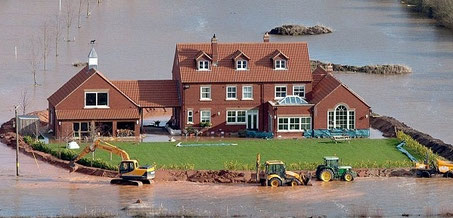How to construct a bund flood barrier to stop flooding.
Opportunities for garden drainage professionals to take on leads in London, the midlands and southern England. details here
Building a Bund to protect your property from flooding.

A Bund described in this article is made from clay based soil formed into an embankment to act as a flood barrier protecting domestic gardens from flooding.
Bunds can also be constructed for use as sound barriers alongside noisy roads, as safety barriers around oil storage tanks and to create micro climate growing areas.
Bunds are also known as Levees, Berms, Flood banks, Stop banks, Earth sound barriers, Flood walls, Flood barriers and Embankments.
A bund is a tried and tested barrier to protect property from flash flooding and rising rivers.
Tools you will need to build a Bund.
You will need gloves, shovels, a digger and dumper or wheelbarrow and a lot of labour or help from friendly neighbours.
The materials needed to construct a Bund are mainly clayey soil, breeze blocks or similar and damp course material or plastic sheeting.
The best material to build a bund flood barrier is soil with high clay content
Facts about clay.
- To construct a Bund to hold back flood water you will need a clay based soil that's free of stone and gravel. The type of soil dug out by builders excavating trenches for footing, etc. in areas of the UK built on clay. London for example has the highest 'shrink-swell clay hazard' in the country.
- Gaps caused by too much gravel or stone in the clay, can cause piping, letting water seep through the Bund.
- Clay when compacted becomes almost impervious and is Ideal for use in building Bunds.
- If you are constructing a Bund for purposes other than protecting your property from flooding it's OK to include soil that contains gravel and some hardcore.
- Depending on the length and height of the Bund you intend to construct, you are going to need a lot of clay based soil. The cheapest source will be local builders excavating soil for footings, etc. They are usually pleased to get rid of this type of subsoil, it cannot, or should not be recycled as topsoil and costs them to dispose of it.
- It is possible, though more expensive, to purchase puddling clay or clay granules.
- The ideal material to build a Bund embankment, is soil containing about 20 to 30% clay.
- Where the clay content of soil is not known, samples can be sent off to a lab for analysis. Or try the tests outlined on this page yourself Puddled clay pond
Construction tips for a bund embankment to protect from flash flooding and overflowing river.
Constructing a Bund / Embankment
- It is important, before piling up the soil, to address the risk of under seepage, that's the flow of water under the Bund. To do this dig out a two foot deep trench along the centre of the area where the Bund will be constructed. Fill this trench with a high content clay soil and form a mound about six inches above ground level.
- Another way to minimise seepage, is to build a breeze block wall, sunk two foot into the ground and rising six to twelve inches above ground level. Line the river side of the wall with a damp course material.
- Now pile up the soil in six inch layers making sure to thoroughly compact each layer before adding the next layer. Repeat until you have reached the required height.
- For a three foot height, the base of the Bund should be minimum three feet wide, wider if you have the space in your garden. Slope both sides to a minimum thickness of two feet at the top.
Finish and Stabilise the Bund construction.
- Smooth off both sides, loose soil is easily eroded and then sprinkle topsoil all over the completed Bank and water well with a hosepipe. Now sow grass seed. The grass will help stabilise the structure and improve the look. When the grass has started to grow, plants like primroses can be planted to further enhance the look of your flood defences.
Maintenance of a Bund Bank.
- It's unlikely that now you have built your flood defence, we will have another rainy winter for years. But, here is the thing, with our British climate we never know, so its worth maintaining it.
- Clay dries out and cracks in hot weather so water it now and again. Another way to keep the clay damp, if you are not growing grass over it, is to cover the bank with plastic sheeting, you can plant through the plastic sheets.
Why do Rivers Flood?
Floods are natural events. Mainly happening when the area of land, rivers and the streams that flow into the main river receives a lot more than the usual amounts of rainwater, causing the level of the water in the river to rise above the level of the bank. The actual flooding can take place at any point along the river and sometimes many miles downstream.
The swollen river is more likely to flood on bends in the river, poorly maintained banks and sections that have become dammed with debris, trapped around fallen trees.
Writing your first book or novel? This new website provides advice and tips to help write, edit, publish, market and promote it https://www.faircop.com/
